Report on Big Data Analytics Applications Across Various Industries
VerifiedAdded on 2021/02/21
|8
|2215
|79
Report
AI Summary
This report provides an overview of big data analytics and its applications across several sectors, including healthcare, education, tourism, transportation, finance, and manufacturing. It explores how big data analytics is used to improve patient care through predictive analytics and electronic health records in healthcare. In education, the report discusses how big data helps teachers and university administrators analyze student performance and develop better strategies. The tourism sector benefits from big data through personalized deals and revenue optimization. Transportation utilizes big data for traffic management and logistics. The finance and banking sector employs it to detect fraud and manage risks. Finally, the manufacturing sector leverages big data to optimize production, reduce costs, and enhance overall profitability. The report cites examples of real-world applications and discusses the benefits and challenges of big data analytics in each sector, highlighting its role in strategic decision-making and innovation.
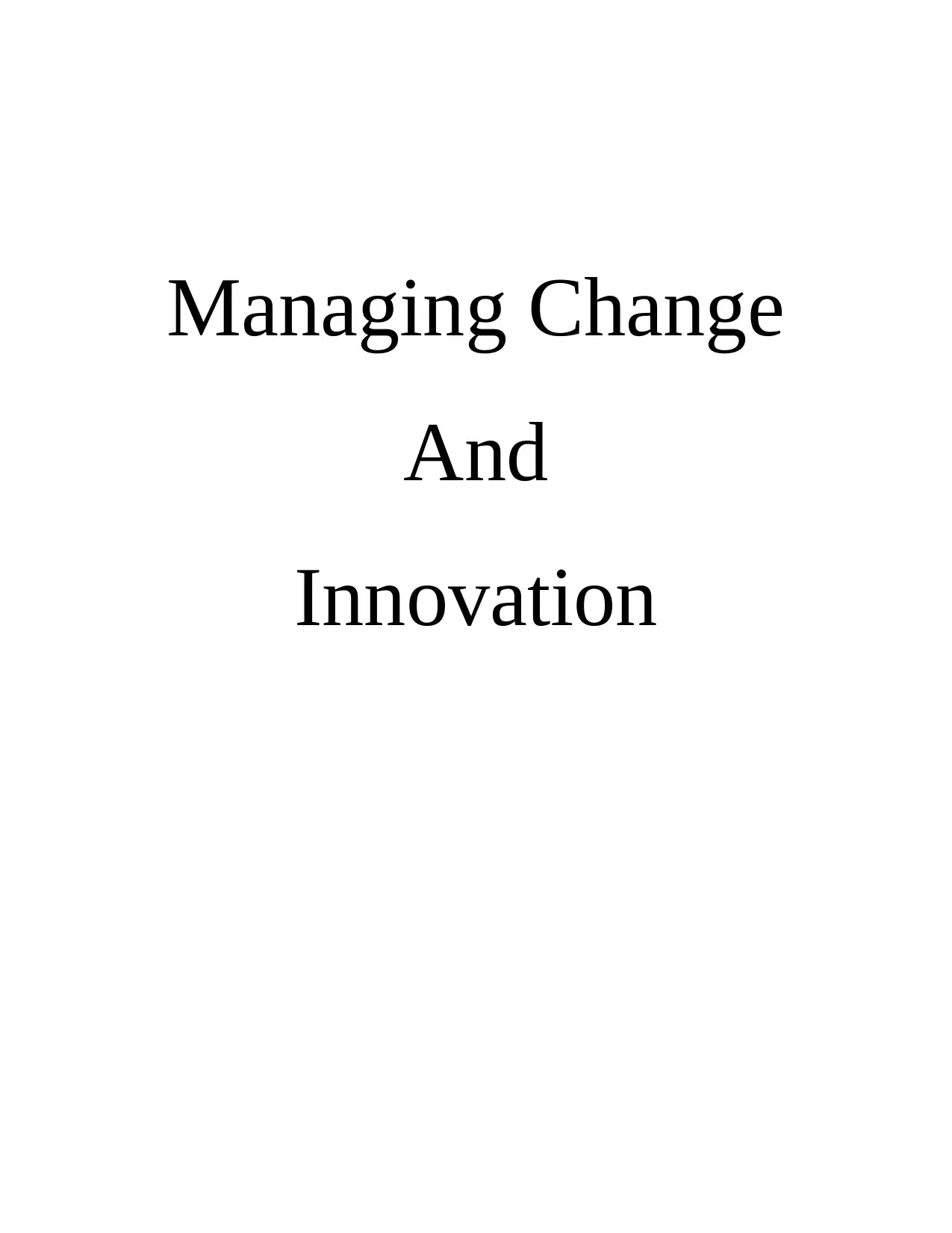
Managing Change
And
Innovation
And
Innovation
Paraphrase This Document
Need a fresh take? Get an instant paraphrase of this document with our AI Paraphraser
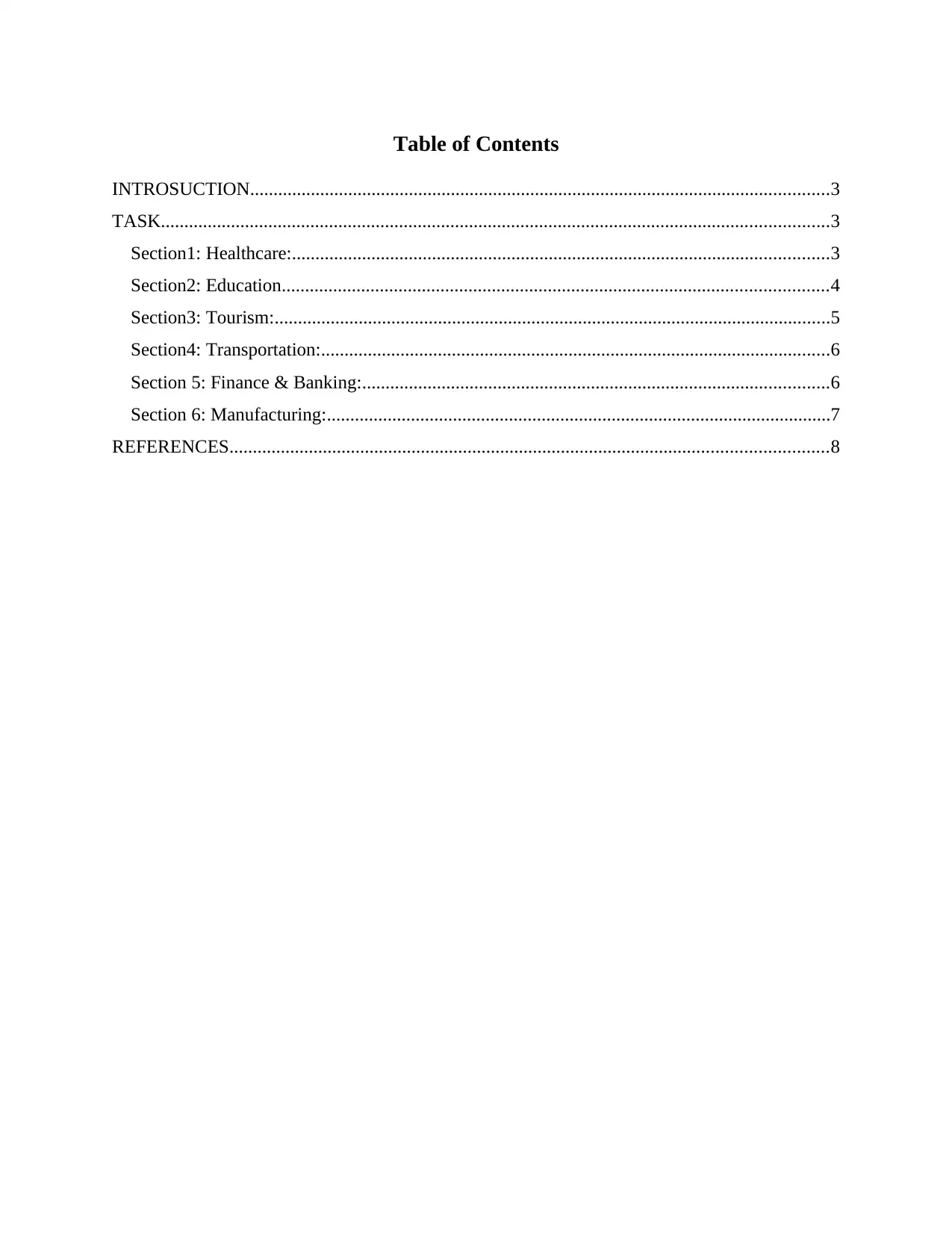
Table of Contents
INTROSUCTION............................................................................................................................3
TASK...............................................................................................................................................3
Section1: Healthcare:...................................................................................................................3
Section2: Education.....................................................................................................................4
Section3: Tourism:.......................................................................................................................5
Section4: Transportation:.............................................................................................................6
Section 5: Finance & Banking:....................................................................................................6
Section 6: Manufacturing:............................................................................................................7
REFERENCES................................................................................................................................8
INTROSUCTION............................................................................................................................3
TASK...............................................................................................................................................3
Section1: Healthcare:...................................................................................................................3
Section2: Education.....................................................................................................................4
Section3: Tourism:.......................................................................................................................5
Section4: Transportation:.............................................................................................................6
Section 5: Finance & Banking:....................................................................................................6
Section 6: Manufacturing:............................................................................................................7
REFERENCES................................................................................................................................8
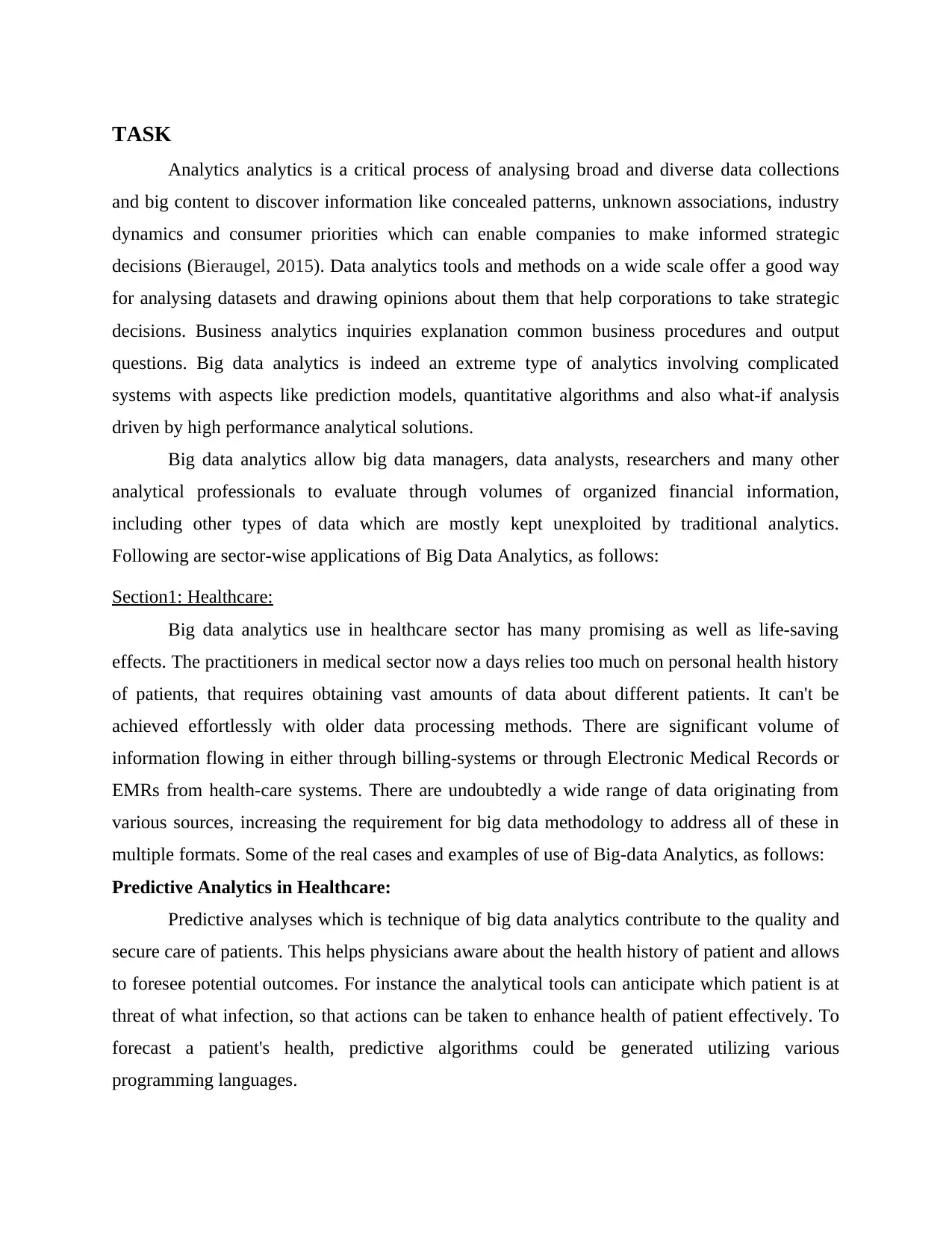
TASK
Analytics analytics is a critical process of analysing broad and diverse data collections
and big content to discover information like concealed patterns, unknown associations, industry
dynamics and consumer priorities which can enable companies to make informed strategic
decisions (Bieraugel, 2015). Data analytics tools and methods on a wide scale offer a good way
for analysing datasets and drawing opinions about them that help corporations to take strategic
decisions. Business analytics inquiries explanation common business procedures and output
questions. Big data analytics is indeed an extreme type of analytics involving complicated
systems with aspects like prediction models, quantitative algorithms and also what-if analysis
driven by high performance analytical solutions.
Big data analytics allow big data managers, data analysts, researchers and many other
analytical professionals to evaluate through volumes of organized financial information,
including other types of data which are mostly kept unexploited by traditional analytics.
Following are sector-wise applications of Big Data Analytics, as follows:
Section1: Healthcare:
Big data analytics use in healthcare sector has many promising as well as life-saving
effects. The practitioners in medical sector now a days relies too much on personal health history
of patients, that requires obtaining vast amounts of data about different patients. It can't be
achieved effortlessly with older data processing methods. There are significant volume of
information flowing in either through billing-systems or through Electronic Medical Records or
EMRs from health-care systems. There are undoubtedly a wide range of data originating from
various sources, increasing the requirement for big data methodology to address all of these in
multiple formats. Some of the real cases and examples of use of Big-data Analytics, as follows:
Predictive Analytics in Healthcare:
Predictive analyses which is technique of big data analytics contribute to the quality and
secure care of patients. This helps physicians aware about the health history of patient and allows
to foresee potential outcomes. For instance the analytical tools can anticipate which patient is at
threat of what infection, so that actions can be taken to enhance health of patient effectively. To
forecast a patient's health, predictive algorithms could be generated utilizing various
programming languages.
Analytics analytics is a critical process of analysing broad and diverse data collections
and big content to discover information like concealed patterns, unknown associations, industry
dynamics and consumer priorities which can enable companies to make informed strategic
decisions (Bieraugel, 2015). Data analytics tools and methods on a wide scale offer a good way
for analysing datasets and drawing opinions about them that help corporations to take strategic
decisions. Business analytics inquiries explanation common business procedures and output
questions. Big data analytics is indeed an extreme type of analytics involving complicated
systems with aspects like prediction models, quantitative algorithms and also what-if analysis
driven by high performance analytical solutions.
Big data analytics allow big data managers, data analysts, researchers and many other
analytical professionals to evaluate through volumes of organized financial information,
including other types of data which are mostly kept unexploited by traditional analytics.
Following are sector-wise applications of Big Data Analytics, as follows:
Section1: Healthcare:
Big data analytics use in healthcare sector has many promising as well as life-saving
effects. The practitioners in medical sector now a days relies too much on personal health history
of patients, that requires obtaining vast amounts of data about different patients. It can't be
achieved effortlessly with older data processing methods. There are significant volume of
information flowing in either through billing-systems or through Electronic Medical Records or
EMRs from health-care systems. There are undoubtedly a wide range of data originating from
various sources, increasing the requirement for big data methodology to address all of these in
multiple formats. Some of the real cases and examples of use of Big-data Analytics, as follows:
Predictive Analytics in Healthcare:
Predictive analyses which is technique of big data analytics contribute to the quality and
secure care of patients. This helps physicians aware about the health history of patient and allows
to foresee potential outcomes. For instance the analytical tools can anticipate which patient is at
threat of what infection, so that actions can be taken to enhance health of patient effectively. To
forecast a patient's health, predictive algorithms could be generated utilizing various
programming languages.
⊘ This is a preview!⊘
Do you want full access?
Subscribe today to unlock all pages.

Trusted by 1+ million students worldwide
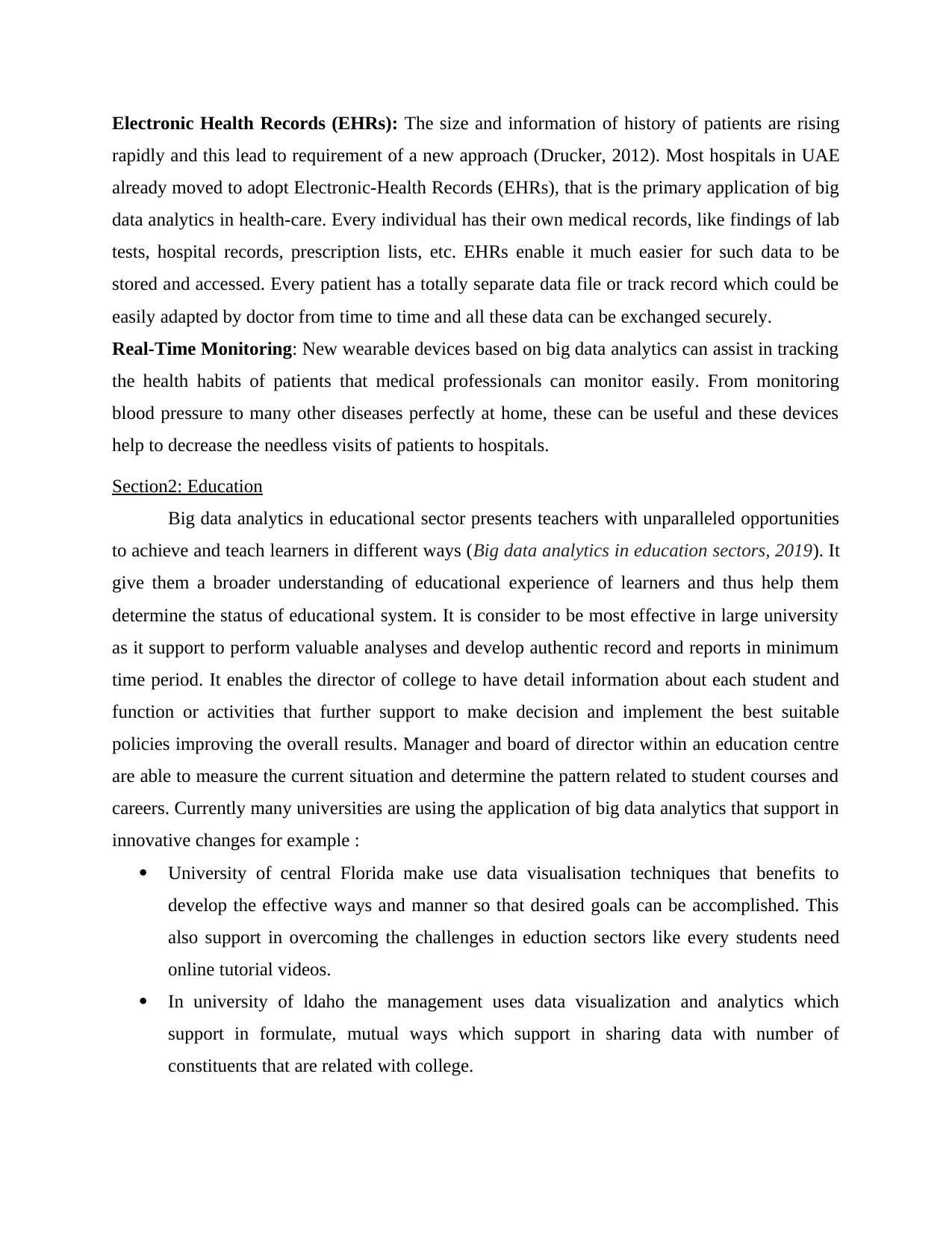
Electronic Health Records (EHRs): The size and information of history of patients are rising
rapidly and this lead to requirement of a new approach (Drucker, 2012). Most hospitals in UAE
already moved to adopt Electronic-Health Records (EHRs), that is the primary application of big
data analytics in health-care. Every individual has their own medical records, like findings of lab
tests, hospital records, prescription lists, etc. EHRs enable it much easier for such data to be
stored and accessed. Every patient has a totally separate data file or track record which could be
easily adapted by doctor from time to time and all these data can be exchanged securely.
Real-Time Monitoring: New wearable devices based on big data analytics can assist in tracking
the health habits of patients that medical professionals can monitor easily. From monitoring
blood pressure to many other diseases perfectly at home, these can be useful and these devices
help to decrease the needless visits of patients to hospitals.
Section2: Education
Big data analytics in educational sector presents teachers with unparalleled opportunities
to achieve and teach learners in different ways (Big data analytics in education sectors, 2019). It
give them a broader understanding of educational experience of learners and thus help them
determine the status of educational system. It is consider to be most effective in large university
as it support to perform valuable analyses and develop authentic record and reports in minimum
time period. It enables the director of college to have detail information about each student and
function or activities that further support to make decision and implement the best suitable
policies improving the overall results. Manager and board of director within an education centre
are able to measure the current situation and determine the pattern related to student courses and
careers. Currently many universities are using the application of big data analytics that support in
innovative changes for example :
University of central Florida make use data visualisation techniques that benefits to
develop the effective ways and manner so that desired goals can be accomplished. This
also support in overcoming the challenges in eduction sectors like every students need
online tutorial videos.
In university of ldaho the management uses data visualization and analytics which
support in formulate, mutual ways which support in sharing data with number of
constituents that are related with college.
rapidly and this lead to requirement of a new approach (Drucker, 2012). Most hospitals in UAE
already moved to adopt Electronic-Health Records (EHRs), that is the primary application of big
data analytics in health-care. Every individual has their own medical records, like findings of lab
tests, hospital records, prescription lists, etc. EHRs enable it much easier for such data to be
stored and accessed. Every patient has a totally separate data file or track record which could be
easily adapted by doctor from time to time and all these data can be exchanged securely.
Real-Time Monitoring: New wearable devices based on big data analytics can assist in tracking
the health habits of patients that medical professionals can monitor easily. From monitoring
blood pressure to many other diseases perfectly at home, these can be useful and these devices
help to decrease the needless visits of patients to hospitals.
Section2: Education
Big data analytics in educational sector presents teachers with unparalleled opportunities
to achieve and teach learners in different ways (Big data analytics in education sectors, 2019). It
give them a broader understanding of educational experience of learners and thus help them
determine the status of educational system. It is consider to be most effective in large university
as it support to perform valuable analyses and develop authentic record and reports in minimum
time period. It enables the director of college to have detail information about each student and
function or activities that further support to make decision and implement the best suitable
policies improving the overall results. Manager and board of director within an education centre
are able to measure the current situation and determine the pattern related to student courses and
careers. Currently many universities are using the application of big data analytics that support in
innovative changes for example :
University of central Florida make use data visualisation techniques that benefits to
develop the effective ways and manner so that desired goals can be accomplished. This
also support in overcoming the challenges in eduction sectors like every students need
online tutorial videos.
In university of ldaho the management uses data visualization and analytics which
support in formulate, mutual ways which support in sharing data with number of
constituents that are related with college.
Paraphrase This Document
Need a fresh take? Get an instant paraphrase of this document with our AI Paraphraser
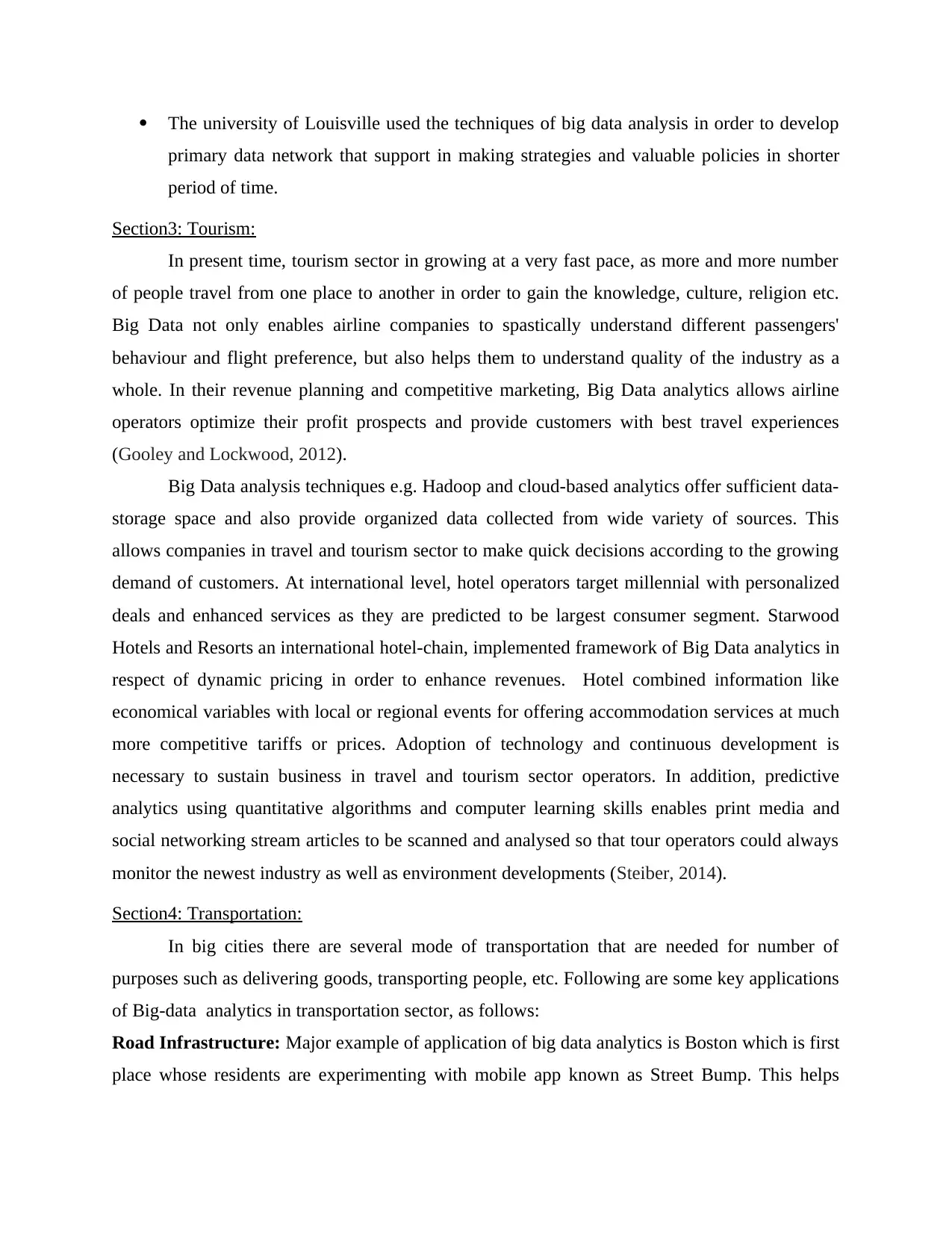
The university of Louisville used the techniques of big data analysis in order to develop
primary data network that support in making strategies and valuable policies in shorter
period of time.
Section3: Tourism:
In present time, tourism sector in growing at a very fast pace, as more and more number
of people travel from one place to another in order to gain the knowledge, culture, religion etc.
Big Data not only enables airline companies to spastically understand different passengers'
behaviour and flight preference, but also helps them to understand quality of the industry as a
whole. In their revenue planning and competitive marketing, Big Data analytics allows airline
operators optimize their profit prospects and provide customers with best travel experiences
(Gooley and Lockwood, 2012).
Big Data analysis techniques e.g. Hadoop and cloud-based analytics offer sufficient data-
storage space and also provide organized data collected from wide variety of sources. This
allows companies in travel and tourism sector to make quick decisions according to the growing
demand of customers. At international level, hotel operators target millennial with personalized
deals and enhanced services as they are predicted to be largest consumer segment. Starwood
Hotels and Resorts an international hotel-chain, implemented framework of Big Data analytics in
respect of dynamic pricing in order to enhance revenues. Hotel combined information like
economical variables with local or regional events for offering accommodation services at much
more competitive tariffs or prices. Adoption of technology and continuous development is
necessary to sustain business in travel and tourism sector operators. In addition, predictive
analytics using quantitative algorithms and computer learning skills enables print media and
social networking stream articles to be scanned and analysed so that tour operators could always
monitor the newest industry as well as environment developments (Steiber, 2014).
Section4: Transportation:
In big cities there are several mode of transportation that are needed for number of
purposes such as delivering goods, transporting people, etc. Following are some key applications
of Big-data analytics in transportation sector, as follows:
Road Infrastructure: Major example of application of big data analytics is Boston which is first
place whose residents are experimenting with mobile app known as Street Bump. This helps
primary data network that support in making strategies and valuable policies in shorter
period of time.
Section3: Tourism:
In present time, tourism sector in growing at a very fast pace, as more and more number
of people travel from one place to another in order to gain the knowledge, culture, religion etc.
Big Data not only enables airline companies to spastically understand different passengers'
behaviour and flight preference, but also helps them to understand quality of the industry as a
whole. In their revenue planning and competitive marketing, Big Data analytics allows airline
operators optimize their profit prospects and provide customers with best travel experiences
(Gooley and Lockwood, 2012).
Big Data analysis techniques e.g. Hadoop and cloud-based analytics offer sufficient data-
storage space and also provide organized data collected from wide variety of sources. This
allows companies in travel and tourism sector to make quick decisions according to the growing
demand of customers. At international level, hotel operators target millennial with personalized
deals and enhanced services as they are predicted to be largest consumer segment. Starwood
Hotels and Resorts an international hotel-chain, implemented framework of Big Data analytics in
respect of dynamic pricing in order to enhance revenues. Hotel combined information like
economical variables with local or regional events for offering accommodation services at much
more competitive tariffs or prices. Adoption of technology and continuous development is
necessary to sustain business in travel and tourism sector operators. In addition, predictive
analytics using quantitative algorithms and computer learning skills enables print media and
social networking stream articles to be scanned and analysed so that tour operators could always
monitor the newest industry as well as environment developments (Steiber, 2014).
Section4: Transportation:
In big cities there are several mode of transportation that are needed for number of
purposes such as delivering goods, transporting people, etc. Following are some key applications
of Big-data analytics in transportation sector, as follows:
Road Infrastructure: Major example of application of big data analytics is Boston which is first
place whose residents are experimenting with mobile app known as Street Bump. This helps
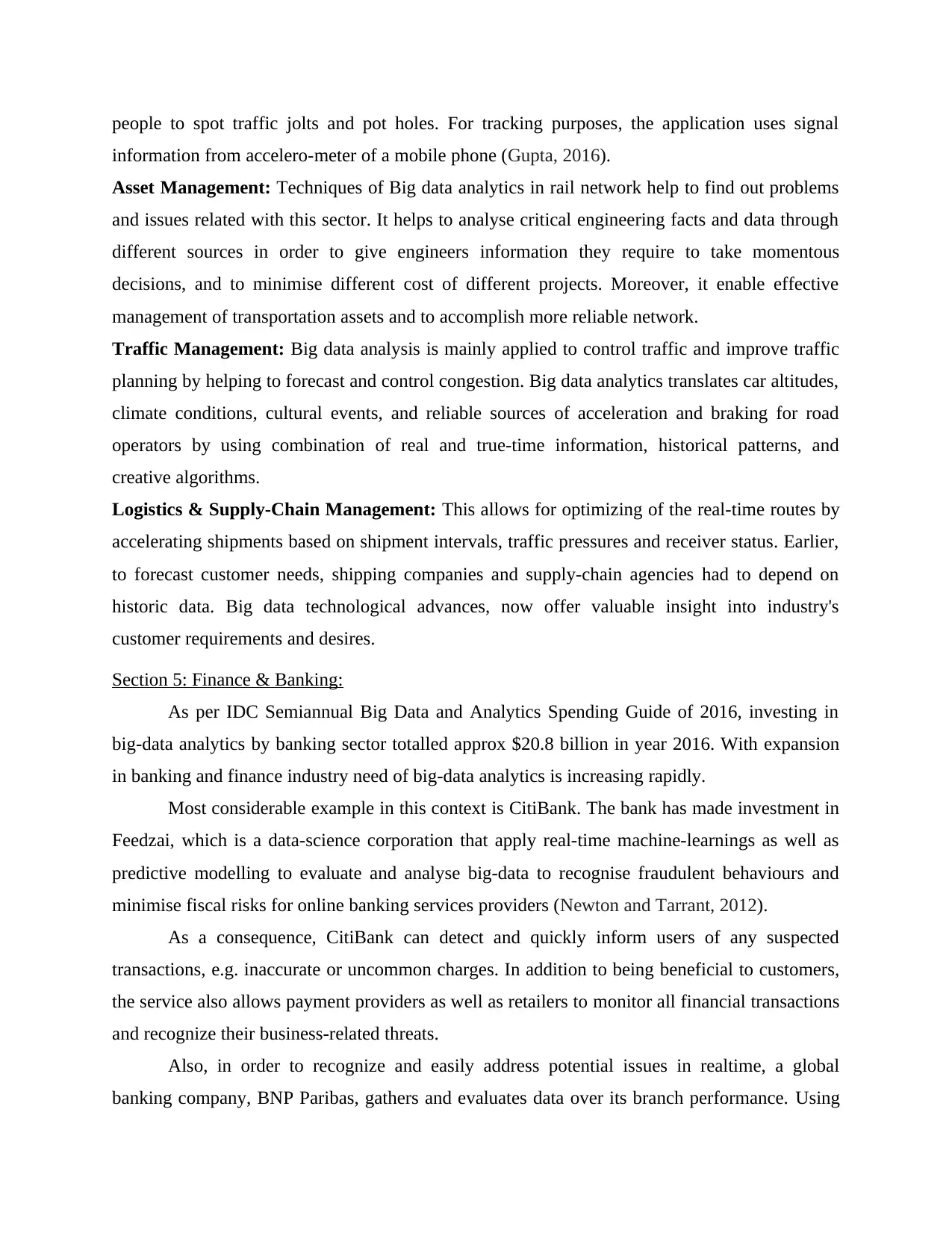
people to spot traffic jolts and pot holes. For tracking purposes, the application uses signal
information from accelero-meter of a mobile phone (Gupta, 2016).
Asset Management: Techniques of Big data analytics in rail network help to find out problems
and issues related with this sector. It helps to analyse critical engineering facts and data through
different sources in order to give engineers information they require to take momentous
decisions, and to minimise different cost of different projects. Moreover, it enable effective
management of transportation assets and to accomplish more reliable network.
Traffic Management: Big data analysis is mainly applied to control traffic and improve traffic
planning by helping to forecast and control congestion. Big data analytics translates car altitudes,
climate conditions, cultural events, and reliable sources of acceleration and braking for road
operators by using combination of real and true-time information, historical patterns, and
creative algorithms.
Logistics & Supply-Chain Management: This allows for optimizing of the real-time routes by
accelerating shipments based on shipment intervals, traffic pressures and receiver status. Earlier,
to forecast customer needs, shipping companies and supply-chain agencies had to depend on
historic data. Big data technological advances, now offer valuable insight into industry's
customer requirements and desires.
Section 5: Finance & Banking:
As per IDC Semiannual Big Data and Analytics Spending Guide of 2016, investing in
big-data analytics by banking sector totalled approx $20.8 billion in year 2016. With expansion
in banking and finance industry need of big-data analytics is increasing rapidly.
Most considerable example in this context is CitiBank. The bank has made investment in
Feedzai, which is a data-science corporation that apply real-time machine-learnings as well as
predictive modelling to evaluate and analyse big-data to recognise fraudulent behaviours and
minimise fiscal risks for online banking services providers (Newton and Tarrant, 2012).
As a consequence, CitiBank can detect and quickly inform users of any suspected
transactions, e.g. inaccurate or uncommon charges. In addition to being beneficial to customers,
the service also allows payment providers as well as retailers to monitor all financial transactions
and recognize their business-related threats.
Also, in order to recognize and easily address potential issues in realtime, a global
banking company, BNP Paribas, gathers and evaluates data over its branch performance. Using
information from accelero-meter of a mobile phone (Gupta, 2016).
Asset Management: Techniques of Big data analytics in rail network help to find out problems
and issues related with this sector. It helps to analyse critical engineering facts and data through
different sources in order to give engineers information they require to take momentous
decisions, and to minimise different cost of different projects. Moreover, it enable effective
management of transportation assets and to accomplish more reliable network.
Traffic Management: Big data analysis is mainly applied to control traffic and improve traffic
planning by helping to forecast and control congestion. Big data analytics translates car altitudes,
climate conditions, cultural events, and reliable sources of acceleration and braking for road
operators by using combination of real and true-time information, historical patterns, and
creative algorithms.
Logistics & Supply-Chain Management: This allows for optimizing of the real-time routes by
accelerating shipments based on shipment intervals, traffic pressures and receiver status. Earlier,
to forecast customer needs, shipping companies and supply-chain agencies had to depend on
historic data. Big data technological advances, now offer valuable insight into industry's
customer requirements and desires.
Section 5: Finance & Banking:
As per IDC Semiannual Big Data and Analytics Spending Guide of 2016, investing in
big-data analytics by banking sector totalled approx $20.8 billion in year 2016. With expansion
in banking and finance industry need of big-data analytics is increasing rapidly.
Most considerable example in this context is CitiBank. The bank has made investment in
Feedzai, which is a data-science corporation that apply real-time machine-learnings as well as
predictive modelling to evaluate and analyse big-data to recognise fraudulent behaviours and
minimise fiscal risks for online banking services providers (Newton and Tarrant, 2012).
As a consequence, CitiBank can detect and quickly inform users of any suspected
transactions, e.g. inaccurate or uncommon charges. In addition to being beneficial to customers,
the service also allows payment providers as well as retailers to monitor all financial transactions
and recognize their business-related threats.
Also, in order to recognize and easily address potential issues in realtime, a global
banking company, BNP Paribas, gathers and evaluates data over its branch performance. Using
⊘ This is a preview!⊘
Do you want full access?
Subscribe today to unlock all pages.

Trusted by 1+ million students worldwide
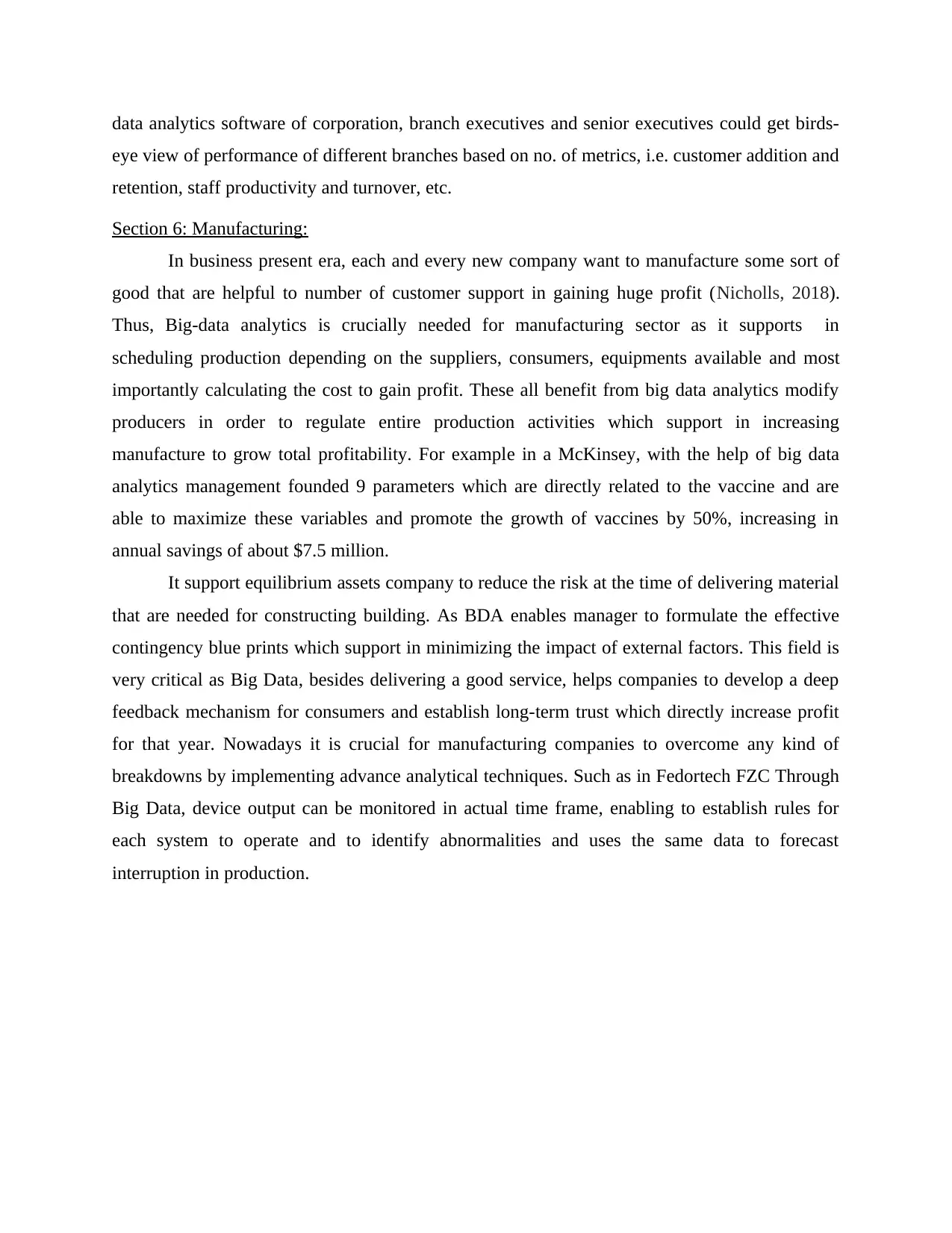
data analytics software of corporation, branch executives and senior executives could get birds-
eye view of performance of different branches based on no. of metrics, i.e. customer addition and
retention, staff productivity and turnover, etc.
Section 6: Manufacturing:
In business present era, each and every new company want to manufacture some sort of
good that are helpful to number of customer support in gaining huge profit (Nicholls, 2018).
Thus, Big-data analytics is crucially needed for manufacturing sector as it supports in
scheduling production depending on the suppliers, consumers, equipments available and most
importantly calculating the cost to gain profit. These all benefit from big data analytics modify
producers in order to regulate entire production activities which support in increasing
manufacture to grow total profitability. For example in a McKinsey, with the help of big data
analytics management founded 9 parameters which are directly related to the vaccine and are
able to maximize these variables and promote the growth of vaccines by 50%, increasing in
annual savings of about $7.5 million.
It support equilibrium assets company to reduce the risk at the time of delivering material
that are needed for constructing building. As BDA enables manager to formulate the effective
contingency blue prints which support in minimizing the impact of external factors. This field is
very critical as Big Data, besides delivering a good service, helps companies to develop a deep
feedback mechanism for consumers and establish long-term trust which directly increase profit
for that year. Nowadays it is crucial for manufacturing companies to overcome any kind of
breakdowns by implementing advance analytical techniques. Such as in Fedortech FZC Through
Big Data, device output can be monitored in actual time frame, enabling to establish rules for
each system to operate and to identify abnormalities and uses the same data to forecast
interruption in production.
eye view of performance of different branches based on no. of metrics, i.e. customer addition and
retention, staff productivity and turnover, etc.
Section 6: Manufacturing:
In business present era, each and every new company want to manufacture some sort of
good that are helpful to number of customer support in gaining huge profit (Nicholls, 2018).
Thus, Big-data analytics is crucially needed for manufacturing sector as it supports in
scheduling production depending on the suppliers, consumers, equipments available and most
importantly calculating the cost to gain profit. These all benefit from big data analytics modify
producers in order to regulate entire production activities which support in increasing
manufacture to grow total profitability. For example in a McKinsey, with the help of big data
analytics management founded 9 parameters which are directly related to the vaccine and are
able to maximize these variables and promote the growth of vaccines by 50%, increasing in
annual savings of about $7.5 million.
It support equilibrium assets company to reduce the risk at the time of delivering material
that are needed for constructing building. As BDA enables manager to formulate the effective
contingency blue prints which support in minimizing the impact of external factors. This field is
very critical as Big Data, besides delivering a good service, helps companies to develop a deep
feedback mechanism for consumers and establish long-term trust which directly increase profit
for that year. Nowadays it is crucial for manufacturing companies to overcome any kind of
breakdowns by implementing advance analytical techniques. Such as in Fedortech FZC Through
Big Data, device output can be monitored in actual time frame, enabling to establish rules for
each system to operate and to identify abnormalities and uses the same data to forecast
interruption in production.
Paraphrase This Document
Need a fresh take? Get an instant paraphrase of this document with our AI Paraphraser
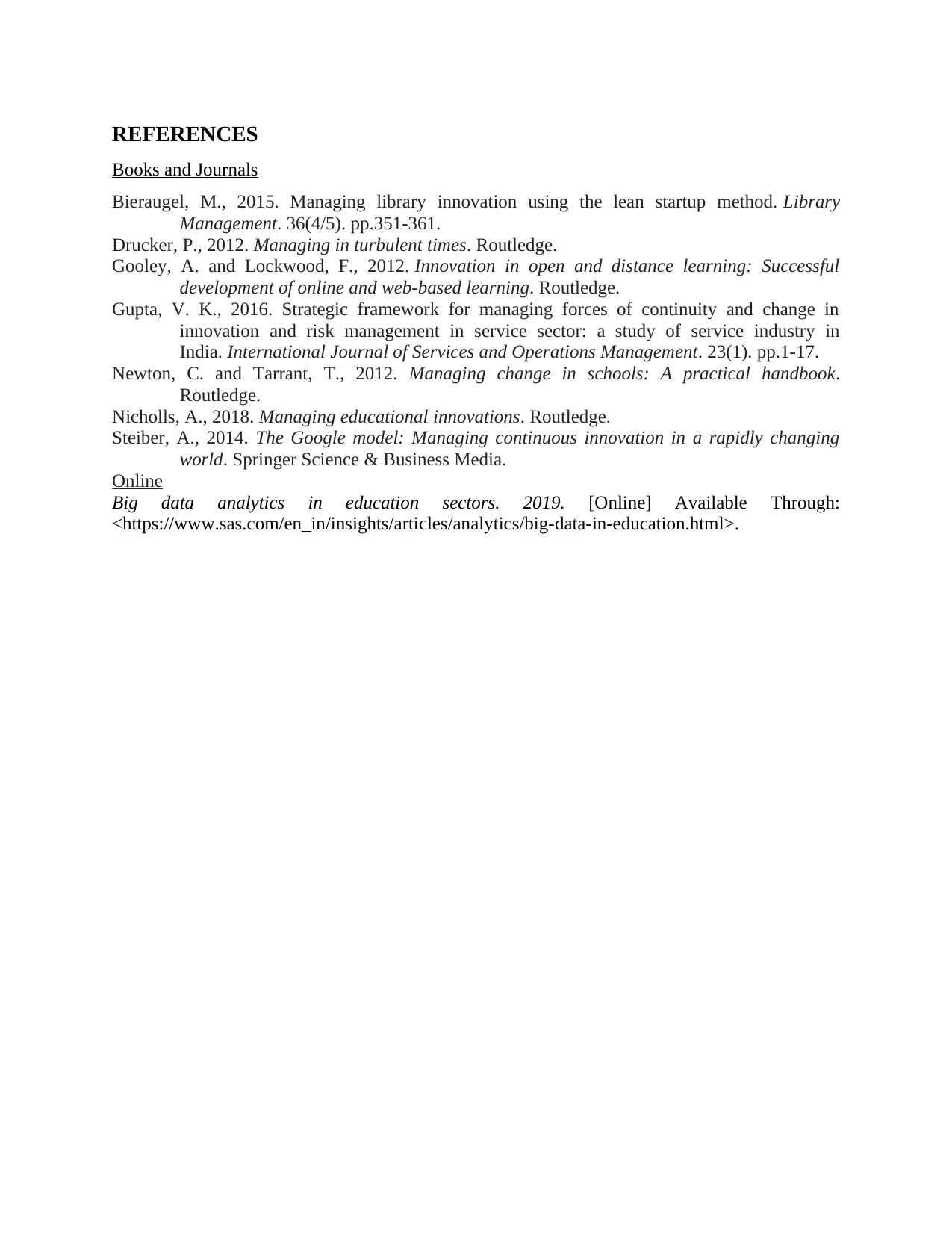
REFERENCES
Books and Journals
Bieraugel, M., 2015. Managing library innovation using the lean startup method. Library
Management. 36(4/5). pp.351-361.
Drucker, P., 2012. Managing in turbulent times. Routledge.
Gooley, A. and Lockwood, F., 2012. Innovation in open and distance learning: Successful
development of online and web-based learning. Routledge.
Gupta, V. K., 2016. Strategic framework for managing forces of continuity and change in
innovation and risk management in service sector: a study of service industry in
India. International Journal of Services and Operations Management. 23(1). pp.1-17.
Newton, C. and Tarrant, T., 2012. Managing change in schools: A practical handbook.
Routledge.
Nicholls, A., 2018. Managing educational innovations. Routledge.
Steiber, A., 2014. The Google model: Managing continuous innovation in a rapidly changing
world. Springer Science & Business Media.
Online
Big data analytics in education sectors. 2019. [Online] Available Through:
<https://www.sas.com/en_in/insights/articles/analytics/big-data-in-education.html>.
Books and Journals
Bieraugel, M., 2015. Managing library innovation using the lean startup method. Library
Management. 36(4/5). pp.351-361.
Drucker, P., 2012. Managing in turbulent times. Routledge.
Gooley, A. and Lockwood, F., 2012. Innovation in open and distance learning: Successful
development of online and web-based learning. Routledge.
Gupta, V. K., 2016. Strategic framework for managing forces of continuity and change in
innovation and risk management in service sector: a study of service industry in
India. International Journal of Services and Operations Management. 23(1). pp.1-17.
Newton, C. and Tarrant, T., 2012. Managing change in schools: A practical handbook.
Routledge.
Nicholls, A., 2018. Managing educational innovations. Routledge.
Steiber, A., 2014. The Google model: Managing continuous innovation in a rapidly changing
world. Springer Science & Business Media.
Online
Big data analytics in education sectors. 2019. [Online] Available Through:
<https://www.sas.com/en_in/insights/articles/analytics/big-data-in-education.html>.
1 out of 8
Related Documents
Your All-in-One AI-Powered Toolkit for Academic Success.
+13062052269
info@desklib.com
Available 24*7 on WhatsApp / Email
![[object Object]](/_next/static/media/star-bottom.7253800d.svg)
Unlock your academic potential
Copyright © 2020–2025 A2Z Services. All Rights Reserved. Developed and managed by ZUCOL.





